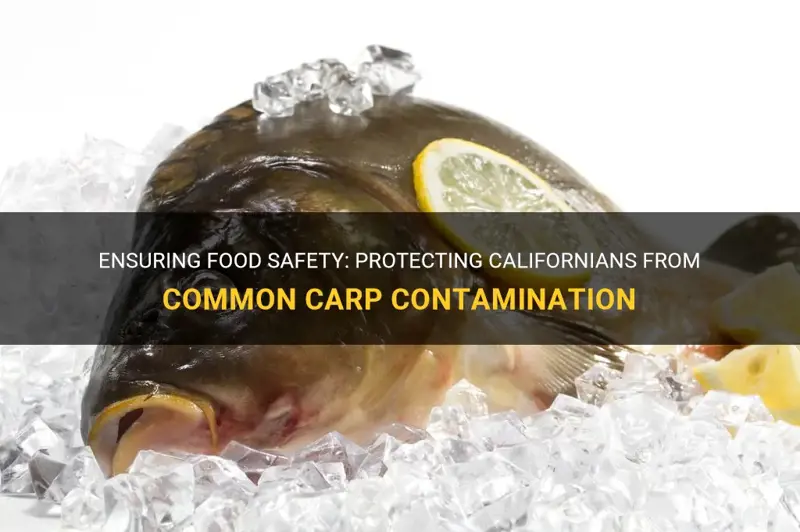Carp Food Safety: What To Know

When it comes to carp food safety, there are several key factors to consider to ensure a healthy and enjoyable dining experience. As a popular ingredient in many cuisines, particularly in Asian and European cooking, carp is a versatile fish that can be prepared in a variety of ways. However, like any food, it’s crucial to handle and cook carp safely to prevent foodborne illnesses.
Understanding Carp and Food Safety
Carp is a freshwater fish that can be found in rivers, lakes, and ponds. It’s a low-fat fish with a mild flavor, making it a popular choice for those looking for a healthier protein option. However, carp can pose some food safety risks if not handled and cooked properly. One of the primary concerns is the potential for carp to contain high levels of contaminants such as mercury, PCBs, and other pollutants. These contaminants can accumulate in the fish’s body over time, particularly in its fatty tissues.
The Importance of Sourcing
The safety of carp as a food source largely depends on where it’s sourced from. Carp from polluted waters can contain high levels of contaminants, which can be harmful if consumed. On the other hand, carp from clean, well-monitored waters is generally safer to eat. When purchasing carp, look for fish that has been certified as safe by local health authorities or reputable fishing organizations. Additionally, consider the fish’s origin and whether it has been farmed or wild-caught. Farmed carp, for instance, may have lower contaminant levels compared to wild-caught carp, depending on the farming practices.
Handling and Storage
Proper handling and storage are critical to maintaining the safety and quality of carp. When handling carp, always use clean utensils and cutting boards to prevent cross-contamination. It’s also essential to store carp at a consistent refrigerator temperature of 40°F (4°C) or below. Never leave carp at room temperature for an extended period, as this can allow bacteria to multiply rapidly. If you plan to freeze carp, make sure it’s wrapped tightly in plastic wrap or aluminum foil and stored at 0°F (-18°C) or below.
Cooking Carp Safely
Cooking carp to the right temperature is vital to killing bacteria and other pathogens that may be present. The recommended internal temperature for cooked fish is at least 145°F (63°C). It’s also important to cook carp evenly, avoiding undercooked or raw areas. One of the safest ways to cook carp is by baking or grilling, as these methods allow for even heat distribution. When cooking carp, use a food thermometer to ensure it reaches a safe internal temperature.
It's worth noting that carp can be a delicate fish to cook, as it has a tendency to dry out if overcooked. To avoid this, cook carp until it flakes easily with a fork, but still retains its moisture.
Health Benefits and Risks
Carp, like other fish, offers several health benefits when consumed in moderation. It’s a good source of protein, omega-3 fatty acids, and various vitamins and minerals. However, there are also potential health risks associated with eating carp, particularly for certain populations. Pregnant women, children, and individuals with compromised immune systems should limit their consumption of carp due to the potential for contaminants. Additionally, individuals with allergies or sensitivities to fish should exercise caution when consuming carp.
FAQ Section
Is it safe to eat carp from local lakes and rivers?
+Not always. The safety of carp from local lakes and rivers depends on the water quality and the presence of contaminants. It's essential to check with local health authorities or fishing organizations to determine if the carp is safe to eat.
Can I cook carp in a way that reduces contaminants?
+While cooking carp cannot eliminate all contaminants, certain methods can help reduce the levels. Removing the skin and trimming the fat can help reduce exposure to contaminants like PCBs and dioxins, which tend to accumulate in fatty tissues.
Are there any specific guidelines for pregnant women eating carp?
+Pregnant women should be cautious when consuming carp due to the potential for contaminants like mercury. The FDA recommends that pregnant women limit their consumption of fish like carp to 6 ounces (170g) per week and avoid eating high-mercury fish altogether.
Conclusion
In conclusion, while carp can be a nutritious and delicious addition to a balanced diet, it’s crucial to prioritize food safety when handling and cooking it. By understanding the potential risks, sourcing carp from clean waters, handling it properly, cooking it to the right temperature, and being aware of health benefits and risks, individuals can enjoy carp while minimizing the risk of foodborne illnesses. Remember, a safe and enjoyable dining experience starts with informed choices about the food we eat.

